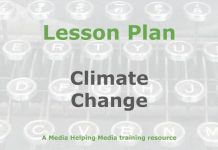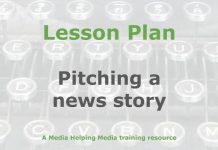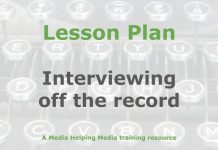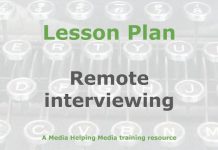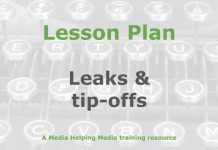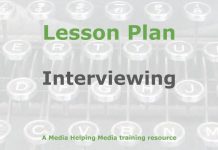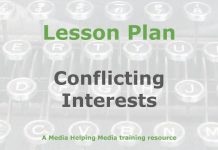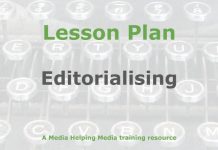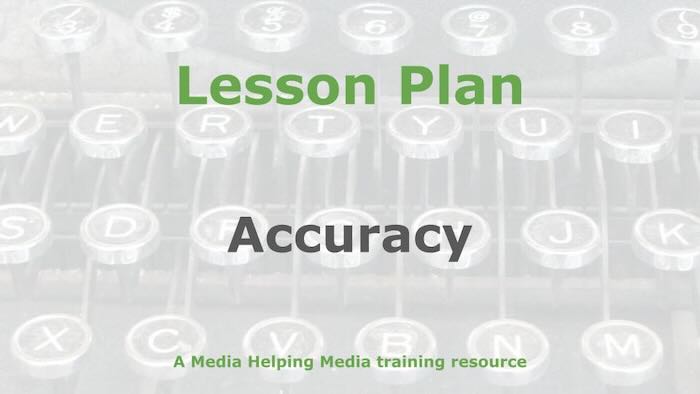 This lesson plan is designed to help journalism students learn how to gather, assemble, and publish information that has been thoroughly checked to ensure it is factual and accurate.
This lesson plan is designed to help journalism students learn how to gather, assemble, and publish information that has been thoroughly checked to ensure it is factual and accurate.
It’s based on the article ‘Accuracy in journalism‘ which is published on Media Helping Media. We suggest you read the article before adapting the lesson outline for your own purposes.
Learning objective
Students will evaluate news reports for accuracy by identifying factual errors and verifying sources. They will also apply techniques to ensure transparency and reliability in their own reporting.
- Student-facing objective: By the end of this lesson students will be able to spot mistakes in news stories, check facts, and make sure their own reports are clear and trustworthy.
- Standards: Helping journalists to produce accurate news reports.
Learning activities
Warm-up
Notice and wonder: Display a short, factual news headline and a brief social media post about the same event. Ask students, “What do you notice? What do you think?” Give them a few minutes to discuss with a partner. Then have several students share their observations and questions. Record these for all to see. Guide the conversation towards noticing differences in detail, tone, and source reliability, setting the stage for evaluating news accuracy.
Direct instruction
- Conceptual understanding: Begin with a discussion on the importance of accuracy in journalism. Present a real-world example of a news story that was later corrected due to inaccuracies. Ask students to identify the potential consequences of the initial errors. Highlight the role of accuracy in maintaining public trust and the ethical responsibilities of journalists.
- Procedural skills and fluency: Introduce the process of fact-checking. Provide a step-by-step guide on how journalists verify information, including:
- Identifying and using first-hand sources.
- Double-checking facts and figures.
- Validating information with multiple independent sources.
- Attributing information to credible sources when verification is incomplete.
- Keeping notes as a record of your fact-checking, in case this is later challenged.
- Hypothetical example
Use a hypothetical news story then walk through the fact-checking process, pausing to allow students to suggest verification methods.
Application: Present a brief, fictional news report containing deliberate inaccuracies. Divide students into small groups and task them with identifying errors and suggesting corrections. Encourage them to apply the fact-checking techniques discussed. Afterward, facilitate a class discussion to review findings and reinforce the importance of accuracy and transparency in journalism.
Guided practice
Think, Pair, Share: Distribute a short news article with potential inaccuracies.
- Think: Individually, students read the article and note any factual errors or unclear information.
- Pair: Students pair up to discuss their findings, focusing on discrepancies and potential corrections.
- Share: Pairs share their insights with the class. Facilitate a discussion on the importance of verifying facts and the impact of inaccuracies.
- Clarify: As a class, clarify any misunderstandings and correct the article collectively.
- Reflect: Conclude with a reflection on how this exercise enhances their ability to produce accurate news reports.
Independent practice
- Provide students with a set of brief news excerpts, each containing potential inaccuracies or unverified claims.
- Instruct students to work individually to identify and correct these inaccuracies using fact-checking techniques.
- Encourage students to document their process, noting sources used for verification and any challenges faced.
- Direct students to practice a related exercise by placing placeholders where they should link to said exercise.
- Circulate throughout the class to observe students as they work and provide support as needed.
Assignment
Ask students to answer these questions:
- What is one technique you learned today for verifying the accuracy of a news report
- Why is it important for journalists to attribute information to credible sources?
- What’s one question you still have from today’s lesson?
Here are some suggested answers:
- Suggested answer to Question 1: Double-checking facts with multiple independent sources.
- Suggested answer to Question 2: It ensures transparency and helps maintain public trust in the news report.
Teacher resources
Differentiation guide
- Advanced learners: Encourage deeper analysis by asking them to evaluate the impact of inaccuracies on public perception and trust. Assign a research task to explore historical cases where journalistic errors had significant consequences. Challenge them to propose strategies for improving accuracy in journalism.
- Striving learners: Simplify tasks by providing a checklist for fact-checking steps. Pair them with peers for collaborative work to build confidence. Use visual aids to illustrate the fact-checking process. Offer additional practice with guided examples to reinforce understanding.
- Background reading: This lesson plan is based on the article ‘Accuracy in journalism‘ which is published on Media Helping Media. We suggest you read the article before adapting the lesson outline for your own purposes.
Notable definitions
- Accuracy: The quality of being correct and precise. In journalism, it refers to the careful verification of facts and information before publication to ensure truthfulness and reliability.
- Fact-checking: The process of verifying information in a news report to confirm its truthfulness and accurate. This involves cross-referencing with reliable sources and evidence.
- Attribution: The act of crediting a source for information used in a news report. It is essential for transparency and helps maintain the credibility of the report.
Required materials
- Notebooks for note-taking and recording observations.
- Printed copies of news articles and excerpts for analysis.
- Access to computers or tablets for online fact-checking.
- Highlighters for marking potential inaccuracies in texts.
- Whiteboard and markers for class discussions and recording observations.
- Projector for displaying news headlines and social media posts.
Lesson summary
- Warm-up
- Direct instruction
- Guided practice
- Independent practice
- Assignment
The free teaching tools at the Khan Academy were used as a basis for converting the original article into a lesson plan.
Related article
